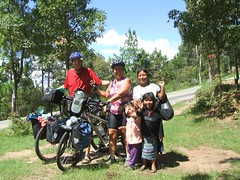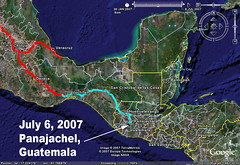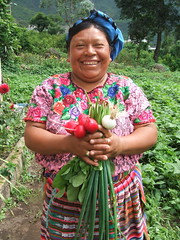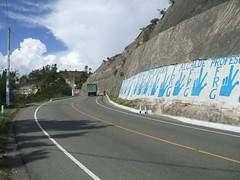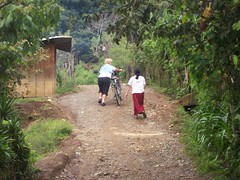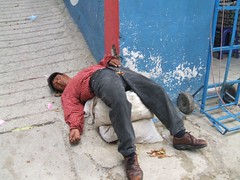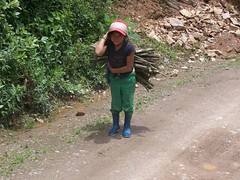Central America Blog (In Order)
Feel free to email send us a note with any questions or comments.
Leaving Mexico and entering Guatemala.
I had heard so many different stories about this country, I did not know what to expect. Would the border crossing be dangerous, with hordes of kids overwhelming us and perhaps slashing our pannier? Would the border immigration officials try to charge us horrendous fees? Would the money changers rip us off? As we rode the hot flat road toward the border, my stomach had a twisted knot and my head hurt. What would happen to us?
Riding the Guatemala Highlands
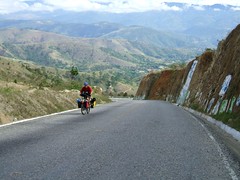
We didn't really know what we were getting into when we heard about the beautiful new road that runs east from Huehuetenango (Way-Way-tenango) - everybody said it had just opened and was a great new road. But it sounded like low traffic and a good road, so we took it. It was probably some of the best riding we've had on the trip. Almost no traffic, beautiful road surface, and sometimes even and shoulder!
It's all huge, brutal, beautiful green mountains. We've never seen so much green. The landscape looks like a quilt because of the efficient agricultural use of this land. In every village and along every road we meet colorful indigenous people who smile and say hi or call out to us, impressed by our trip. Often we hear someone yelling out "bye-bye" in English or the young children come running out of their house, waving and in unison cryout "Gringo Gringo". Nancy usually responds with Ninos! Ninos! (children, children) and gives a hearthy wave back.
In every village the people have a different "tipica" outfit, and the women's outfits are just absolutely gorgeous. I don't know what it would be like to live in a village where all the women wore the same dress every day, but the dresses they wear are beautiful. And each one tells a specific story; the women weave their own "huipiles", and it often requires three months of near-full-time effort to weave one. read more here... lee mas aquí... »
Volunteering for Kiva.org - A Major Change of Pace!

As we were riding through Mexico, we were really impacted by the poverty we saw, and became tremendously interested in the concept of microfinance, the practice of offering small loans ($100-$1000, usually), without requiring collateral, to tiny businesses. It turns out that last year's Nobel Peace Price winner, Mohammed Yunus, is the originator of the concept, and his book "Banker to the Poor" is tremendously inspiring. What they did with tiny, collateral-free loans in Bangladesh is the most hopeful story about alleviating poverty that I've ever heard in my life.
Where We Are - Early July 2007
In the past month we rode from the southern part of Oaxaca, Mexico along the Pacific coast for a few days, then up a huge climb into the mountains of Chiapas. Nancy liked the climate so much when we got up into the mountains that we stayed for two weeks and she studied Spanish. When we got going again, it was just a few days into Guatemala and then a glorious week or so exploring the green, mountainous western highlands of Guatemala.
New Pictures
Donde Estamos, Julio de 2007
En este mes pasado andamos desde el sur de Oaxaca en la costa unos días, y entonces tuvimos una subida muy grande hasta las montañas de Chiapas. A Nancy le gustó tanto el clima, que nos quedamos allí dos semanas para estudiar español. Después de eso, pasamos en pocos días hasta Guatemala y una semana bonita de las montañas de su oeste.
Nuevas Fotos
Hay muchas fotos nuevas:
Nancy's Second Day of Interviews
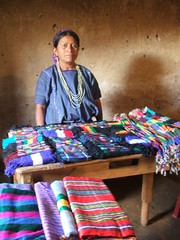
Patti (the Friendship facilitator) and I hopped into the taxi (really the back of a pickup). We snaked our way along the shore and up the side of a mountain -- the view was incredible. As I looked across the emerald lake toward the towering volcanoes, I wondered how such a beautiful place could house such incredible poverty.
All day I sat with the Mayan women in their homes, business and community center learning about their struggles, victories and dreams.
These people had been living in a war-torn area for twenty years only to be further pummeled by the incredible natural disaster Hurricane Stan in 2005. The torrential rains as a result of the hurricane washed away many communities. Whole neighborhoods no longer exist because of the mudslides that swallowed up the land the neighborhood sat on and with it thousands of people. It threw these people further into grave poverty.
The ride to Xela (Quetzaltenango)
What we're doing in our daily work

During the week, we go to a village every morning and meet with one of the women who are the workhorses of Friendship Bridge, the "facilitators". These are the women who form the credit groups and know all of FB's clients. The facilitator will take us to one of more of the clients' homes and may stay with us or may deliver us over to the women. We then sit down and chat with as many as six or seven families, one at a time, about their business, their life, and what they're doing with their loan.
What is Microfinance Anyway?
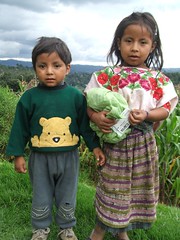
The amazing man who won last year's (2006) Nobel Peace Prize pioneered the use of tiny loans without a requirement for collateral or security to poor people. Mohammed Yunus maintains with great success that if you just give poor people access to capital, they can make their own way in the world with their own businesses. His book, Banker to the Poor, is worth every minute of the time you take to read it - it's in every library and every bookstore and here on Amazon.com. It's the most hopeful book about poverty in the world that you will ever read. Yunus, with 25 years of experience in this, maintains that poor people pay off their loans at a much higher rate than the rich ones, and that simply providing capital in amounts like $100-$500 can transform the life of the poor by enabling them to start their own tiny businesses.
Women We've Met Recently
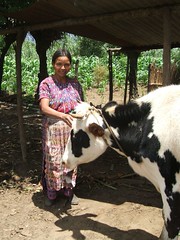
Last week Nancy met Clara Ajsoc in the highland village of Santa Clara La Laguna. Clara used her Friendship Bridge loan to buy a calf, which she raised, only to lose it to a sudden illness, leaving a young calf behind. But she bottlefed that one and raised it up successfully, and she now sells milk and cheese, where she had no livelihood before. And she wants to get another calf.
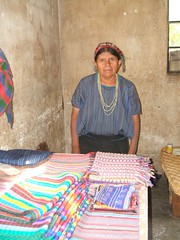
Women we visited in La Estancia de la Cruz
The women we visited Tuesday in La Estancia de la Cruz have been working in the fields all their lives and they know no other way to make a living. As young children they did not go to school because they needed to help the family in the fields. The land here is very rich because the volcanic soil and the 6 months of rain.
None of the women we met with today own their own land. They rent a plot and also work for someone else. With the help from Friendship Bridge, the women are able to rent a 40'x40' plot and grow their own flowers and vegetables. They have a chance to dream and maybe educate their children if there is enough money to buy shoes, paper, pencils and needed supplies. Currently some families do not send their children to school either because they need the help in the field or they just do not have the money to send the children to school.
The month of July is known as the hunger time because the food they had stocked piles are nearly depleted The growing season is February to August and they corn is not ready to harvest.
After interviewing the women, writing their individual stories and taking wonderful photographs of the women in their traditional colorful Mayan clothing, we got ready to leave. read more here... lee mas aquí... »
Guatemala's GNP: Cellphones and Politics
Judging from the number of places that sell cellphones and prepaid cards, cellphones must account for about 50% of the GNP of Guatemala. Today we were out in a pretty remote village where the women scratch together money to rent a small plot on which to grow onions. They have next to nothing. But a phone rang somewhere and our hostess pulled a cellphone out of her brassierre...
Escuela Para todos: School for Everybody

Nancy's been laughing at me for weeks now because I've been devouring a little "almanac" I bought in Chichicastenango, which cost me about $1.40. It's a little book maybe a little like the Old Farmer's Almanac, but with more content and, for me, more cultural insight. The "Escuela Para Todos", or "School for Everybody", is published in Costa Rica expressly for the rural people of Central America, and I've learned so much about rural life from it. It's written at a fairly simple vocabulary level and also has pictures, and those of course help me with the language. If you're studying Spanish, this is the best little reader I've ever come across.
But it's the content that has enthralled me. There's the history of Central American independence, and how it was all one country at first, and how some would like it to be that way again. And how mosquitoes do their dirty deeds and how to prevent the spread of Dengue fever. And how to make concrete posts for fencing and improve the grass in your pastures, all things I never thought much about.
But the very best piece was a little mini-novel telling the story of a girl who got married when she was already pregnant by another man. It turned out OK in the end. read more here... lee mas aquí... »
A Not-So-Good Interview in San Francisco Javier
Morning Road Near San Francisco Javier
This morning we woke up at 4am to catch a microbus from Nebaj, Quiche, Guatemala to interview a group of women in San Francisco Javier. The reason for the interview is to write the story of their business and lives in order to help obtain microloans on Kiva.org for Friendship Bridge in Guatemala. The rain was pouring as we made our way through the deep puddles of the dark streets. Only a few people were out at this time of the morning, walking in the rain underneath thin plastic sheets and clogging along in the total rubber boots so many of the campesinos wear in the fields. A few men hid in the shadows trying to stay dry or sobering up from the night's celebration. This week is the town's annual festival for its patron saint.
We got on the bus a little after 5am. It plowed out of town and followed a rough dirt road for about an hour. The darkness was made more intense by the low clouds that surround this incredible volcanic landscape. The morning light seeped though the misty morning. Clouds obscured most of the surrounding mountains but we got an occasional glimpse of the top of a-not-so distant volcano.
Do any of you have cameras to spare? And monthly update...
We'd like to ask your help with something: We're coming home for a visit next month and we're going to try to get together 12 digital cameras for Friendship Bridge to use to continue the work we've been doing, posting profiles on Kiva.org to raise loans for the women. Do any of you have digital cameras that you don't want any more? We don't need this year's model - in fact, 2-5 year old cameras would be great. If you have one that you could send to Denver, or if you would like to donate money to this cause, please let us know at randyAndNancy@hobobiker.com. All 12 cameras could probably be bought new for around $1200, but used cameras should work fine too.
We have new photos on the website,
Donde nos encontramos y lo que estamos haciendo - Agosto de 2007
Puente De Amistad hace préstamos pequenos a microempresas para que puedan amplificar o mantener sus negocios. Por ejemplo, algunas mujeres quieren comprar una oveja, o el hilo para su tejido, o productos para sus tienditas. Lo que nosotros estamos haciendo es visitando a las señoras y sacando sus fotos y entrevistandolas para poner un perfil en Kiva.org. Kiva es una página web que muestra los perfiles de prestadores en todas partes del mundo desarollando, para que inversores del mundo desarollado puedan hacer préstamos a ellos.
Drunks in the street
One of the more disturbing things about a couple of the places we've been recently is seeing drunks just laying unconscious on the sidewalk, or even sprawling out into the street. There seems to be no custom of getting them off the street, or having the police come and bundle them off to a detox center. They just collapse and sleep it off right there in front of everybody. One place where we used the internet we regularly had to step over a drunk to walk in the front door. Of course this is ugly. We know that this level drunkenness happens everywhere, but it seems like our custom at home is that it's hidden inside somewhere, or if not the police make sure that it's removed quickly from public view. Sometimes it's so extreme here that we wonder whether it's some kind of an art form. Just how drunk can you get before you have to collapse and start drinking? read more here... lee mas aquí... »
A Weekend Ride to Antigua Guatemala
Fancy bike gear: Sandals
By the way, both of us abandoned fancy clipless pedals and shoes some time ago (like in Victoria, British Columbia). For me, it's just that I want only one pair of shoes, and a clip isn't a very friendly thing on your one pair of shoes. For Nancy, it's that she never does get all that confident about the clipped-in thing. Anyway, we're just normal people with normal shoes these days. Or sandals, that is.
The amazing wood carriers of Guatemala
This boy said he had only a 1-hour walk with his load, but we know many carry their loads farther. Some are gathering wood for their own use, but many people are also gathering the wood for sale and carrying it many miles, since it's the only way they have to earn a little cash.

